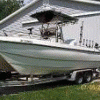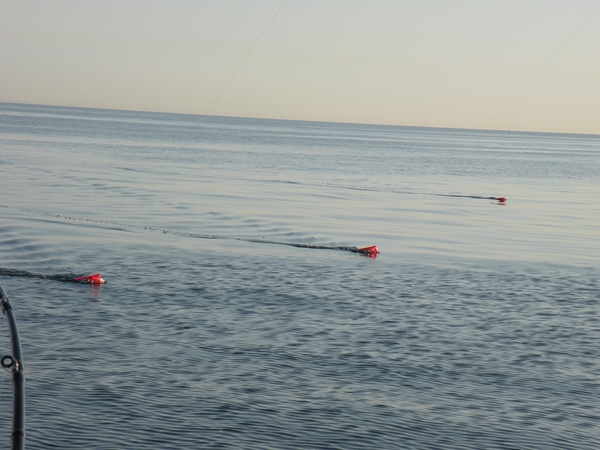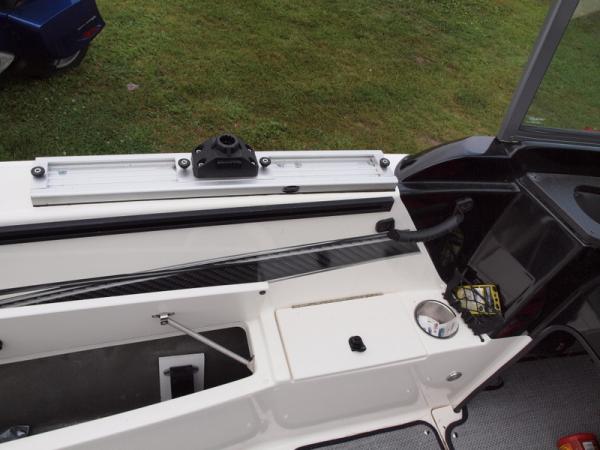-
Posts
844 -
Joined
-
Last visited
Content Type
Profiles
Forums
Events
Store
Gallery
Everything posted by SeaCatMich
-
My two wire divers almost always have meat rigs on them and are in the water every trip. They almost always take bigger fish too and there is nothing better than a decent King hitting meat on a wire diver. I mainly use the Erie Dearie Premium strips (ballyhoo) but will usually put a strip on one and a whole brined herring or alewife on the other. If one is getting hit and the other isn't, then I put the active type of bait on the other one too.
-
- Are there different brands/test of wire and what is recommended? Lots of different brands -- Blood Run, Torpedo, Mason, Malin. Most common used is 30# test but also available in 20 & 40# test Most brands are 7 strand; Torpedo Diver sells a 19 strand - Will I likely need a larger capacity reel vs. my current braid reels? Probably not and likely smaller will work - An Okuma 30 series, Shimano 600, Daiwa 47 will hold 1,000' of wire nearly perfectly with only enough mono to cover the spool and not let the wire slip on the spool. I actually have a set screw/post on my reels to tie the wire too and don't need the mono base. - Will I need different poles/line guides? I am a strong advocate for roller rods for wire. "Regular" ceramic or oxcide guide rods will work but the friction is significantly reduced with rollers and this makes it easier to reel in. Ideally the rod would also have a swivel tip roller tip guide -- Shimano, Daiwa and Okuma all offer models with the swivel tip. On a regular rod, most people go to a Twillie Tip or a roller instead of the ring guide. - Do you use braid backer, then wire, then a leader? If so, use a knot or a swivel for the connections? 1,000' of wire on the reel with only enough backing to prevent slipping on the spool. When i used backing I connected it to the wire with a small Spro swivel. Never an issue with this getting off the reel since all 1,000' of wire would have to be out first. The most I have ever had a fish take out on wire is 800'. No leader -- direct to the diver with a strong snap swivel. Knot for the wire to Spro backing connection and/or the terminal snap swivel is an easy to tie knot described as an overhand knot. Here is a link to a how to for the knot: http://www.lotsa.org/Wire%20Line%20Knot.htm
-

Port Sheldon 8/10 PM
SeaCatMich replied to RogueRiver's topic in Michigan Waters Fishing Reports - Salmon and Trout
You may also need to turn down the gain on your fishfinder as this can cause lots of noise near the surface, even with a properly mounted transducer. I always use the manual gain setting on my sonar. Easiest way to get it set correctly is to set the max depth range to a little over about two times the current depth (250 if in 100 FOW) and then increase the gain until you start seeing a second bottom reading at two times the actual depth (both 100 and 200 in this example). That should be enough power to see rigger weights and both bait and game fish on the graph. As you go deeper you may need to increase the gain to get good readings. After a few times you will start to get a feel for how high the gain needs to be. I have Raymarine electronics so I can't speak to the HDS10 specifically, but this has worked well on all of the sonar units of various manufactures I have had over the last 20 years. -

Fall Tactics - New to GL site
SeaCatMich replied to mali0056's topic in Wisconsin Waters Fishing Reports - Salmon and Trout
Many different color plugs will work. My favorites are florescent green, green w/ black ladder back, chrome w/ red head, pearl, wonder-bread. Other good lures include super mag spoons (glows especially in low light conditions) and Spin Doctor and Bechold Hoochie Mama flashers with flies (pearl white glow flashers with green, white, and blue flies). All work well off riggers and divers. Leadcore & copper outfits are best left in the boat in typical harbor patrol "combat" fishing situations. It also pays to beef up the line on downrigger reels as you don't have the room to let the fish get out far from the boat -- 20#+ test. -

Port Sheldon 8/10 PM
SeaCatMich replied to RogueRiver's topic in Michigan Waters Fishing Reports - Salmon and Trout
Sounds like you are getting turbulence around your transducer which is reading as noise in the top 20'. I'd check where you have the transducer mounted to make sure it is getting clear water coming across it. Make sure it is about 1/8" below the edge of the hull and the rear should be tilted down a little for best results. Ideally the hull should be smooth in front of the transducer -- if it is behind a strake or rivets this can cause air bubbles or turbulent water that will cause the noise. -
The day didn't start good as we didn't launch until about 8 am missing the dawn bite. We headed out southwest to 120 FOW and started scouting for marks. Didn't find much until we got to 160 where we set lines. With only 2 of us we went with 2 riggers, 2 wire divers, and 2 inline board rods -- seemed odd since every other trip this year has had 3 or 4 anglers and more rods. Action started right away. First put out the FishHawk X4 rigger with a mag Stinger NBK and it got hit as the second rigger was being set. Minutes later I was letting a wire diver out 120 on 1 with a UV Black Momba BW meat rig that got hit at 55' out -- missed the fish though. The hot rod for the day was a 300 32# copper with a mag Moonshine RV wonder bread spoon. Rigger - 60' Mag Stinger NBK, Steelhead, lost on 2nd jump. 0 for 1 Wire diver - 55' out (going for 120') UV Black Momba meat rig, ??? lost because didn't see it quick enough. 0 for 2. 300 32# copper Mag Moonshine RV Wonder Bread, 8# Steelhead. 1 for 3 Rigger - 55' but on a free slider orange/silver Lucky Lure, 6# Steelhead, 4 jumps within 50' of the back of the boat. Last jump went right in the landing net. 2 for 4 300 32# copper Mag Moonshine RV Wonder Bread, 9# Laker. 3 for 5 300 32# copper Mag Moonshine RV Wonder Bread, Steelhead, lost. 3 for 6 *** At this point we put out a 2nd Moonshine RV Wonder Bread on the 45# copper. 300 45# copper Mag Moonshine RV Wonder Bread, 12# Steelhead. 4 for 7 300 32# copper Mag Moonshine RV Wonder Bread, 13@ Steelhead, 5 for 8 300 32# copper Mag Moonshine RV Wonder Bread, don't know but had to be a very good King since it made multiple good runs and head shakes before getting into the other copper and managed to somehow open the Sampo snap swivel. lost . 5 for 9 Rigger - 55' Mag Blue Whale, 7# King, hit 3 seconds after I popped the rigger off to change the lure and let it flutter up. 6 for 10. Overall a decent day. Would have been a great day if the big King hadn't gotten off. I had commented earlier in the day to my fishing buddy that coppers are not too much fun unless the fish is a good sized King as they turn the fight of other fish into what you get from walleye. This one really proved how powerful a King is as it made multiple good runs prior to getting the Walleye board off and then two or three more with copper back on the reel. Of course I don't really know how big it was since we never got it closer than 200', but I'm sure it was over 20#. One of the ones that will give me nightmares until the next big King is in the net. We spent most of the day trolling between 120 and 180 FOW on SW, SE, NW, NE trolls from Holland down to Saugatuck with most of the action from 120 to 140 FOW We never really marked many fish anywhere. Most marks were either 100 to 130' down or in the 40 to 60' range. Tried putting a rigger deeper at times but no hits. Odd that the wire divers with meat rigs only took the one rip early. Most trips this year have had them be the hot presentation.
-

Atlantic Salmon (St.Marys River) Losing Fish
SeaCatMich replied to archie_james_c's topic in Great Lakes Fishing Discussion
The bend of the rod on the downrigger has little to do with setting the hook. It mainly helps take up slack line after the hit and in my opinion tells me I have the release set tight enough to set the hook. If the release is adjustable, you want it tight enough to not let the line pop out without some resistance when the fish hits and to hold the rod in the loaded bend. If they are not adjustable tension, then put the line deeper in the release pads. You don't want it too tight as this will prevent you from popping the line off of it from the boat when you want to change lures and prevent a fish from pulling the line loose. Takes some trial and error. Best gauge to me that it is set right is to have the good bend in the rod, but also be able to pop it loose with a quick snap of the rod. I have not used the Scotty releases but have heard very good things about them. Can't say that I have ever really liked the various brands of pinch pad releases. I used the Walker "shot gun shell" releases for years and then went to the Blacks/Dubro ones which worked well. Three years a go I changed to the Chamberlain release because it allows for two tension settings == one for the lure/strike and a second for the rod. It is especially effective when the target species are not big or hard hitting (arly season *small* Coho, browns, and walleye). Not as valuable for Steelhead, Kings, and late season Coho where you usually need a pretty strong setting on the release. -

Atlantic Salmon (St.Marys River) Losing Fish
SeaCatMich replied to archie_james_c's topic in Great Lakes Fishing Discussion
The only yellow pinch pad releases I am aware of are the light tension OffShore Tackle planer board releases (model OR10). Are these what you are using? If you are and you are using them on downriggers, then I think this is your problem. Use a real downrigger release. Are you getting a good bend in the rod when it is set in the downrigger? If you don't have them really bent or the rod has false releases if you put more bend in it, then I'd say you don't have the line in the pinch pad far enough to get a good hookset on the fish. -
Overhand loop knot for me too, but I go through two times.
-
Here is a list of all the participating restaurants: http://www.michigancatchandcook.com/charter-boats/wpbdm-category/michigan-restaurants/
-
The biggest issue with braid on downriggers is that spiney water fleas get on it. I have a brand new 100 yard spool of 200# test Power Pro that I would sell if you decide you want to try it.
-
It has been a few years since I launched in Saugatuck. Used the ramp downtown near the Big Lake Outfitters shop. The ramp was plenty deep but the concrete under the water is pretty short. Launched okay but put the back tires on the trailer past the concrete to get in far enough to get the boat loaded. No parking other than the streets near the ramp -- not a good idea on a weekend in Saugatuck. I was told that the ramp up river out near the I196 expressway is very shallow and havigation to the lake can be an adventure. I would contact some of the big marinas to see if they have a ramp, dockage and trailer parking. Tower Marine has a good size operation there.
-
-
I figured it out
-
I run everything from 3 colors through 300 45# coppers off my Walleye boards and never have the nose up. I bought mine before the TX-22 model was released. I can't say that I have really ever looked at the TX-22 because I think they are smaller and the Walleye boards are maxed out with the 300 copper.
-
-

Holland 7-31 am
SeaCatMich replied to I wanna go fast's topic in Michigan Waters Fishing Reports - Salmon and Trout
Salmon? -
I have a whole bunch of Laurvicks left over from when I used big boards (actually Otterboats) that I would sell. They work great but since I have gone to inlines they are just sitting in the garage.
-

a few from Lake O so far
SeaCatMich replied to gordymohr's topic in Ontario Waters Fishing Reports - Salmon and Trout
What is the lure in the first picture? -

What does it take to get a weather bouy???
SeaCatMich replied to UBDSLO1's topic in General Discussion
Contact GLF member Everhamme. He coordinates the buoys off Holland and Ludington. A year ago he posted asking for suggestions for another buoy. -

Water temps
SeaCatMich replied to JeffreySB1's topic in Michigan Waters Fishing Reports - Salmon and Trout
-
-
How about putting the tracks on the rear deck in the back corners? The Traxstech risers should get the booms above the gunnels if the booms are long enough. Might be a pain to use that far back though. Traxstech also has rail mounts for the tracks and I know they would be good for rod holders, but I'm not so sure about a downrigger. I would contact Jeff at Traxstech to see what he recommends.
-

Water temps
SeaCatMich replied to JeffreySB1's topic in Michigan Waters Fishing Reports - Salmon and Trout
Today's 5' seas are supposed to be down to 1-2' by tomorrow. Should have fish at the pier heads and with 1' seas the rest of the week may keep thm close too. Probably true for all of the river mouths. -
I 2nd the suggestion for Seng's.



